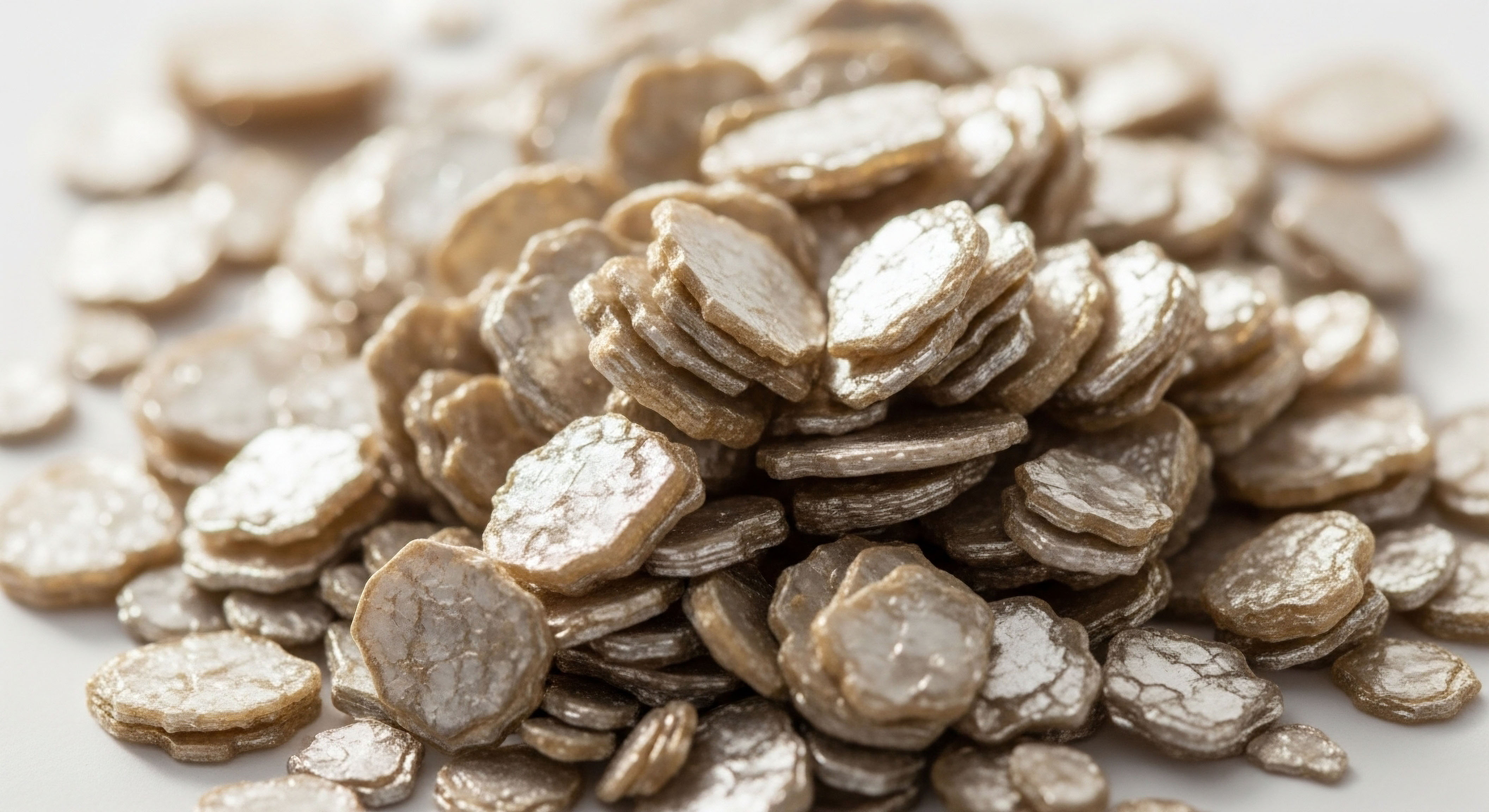

Fundamentals
Many individuals experience a subtle yet persistent shift in their overall vitality as the years progress. Perhaps you have noticed a gradual decline in energy, a diminished sense of drive, or a change in body composition that feels unfamiliar. These sensations are not merely signs of aging; they often signal a deeper recalibration within the body’s intricate hormonal messaging system.
Understanding these internal shifts, particularly concerning testosterone and its metabolic pathways, represents a powerful step toward reclaiming a robust sense of well-being. Our bodies are complex, self-regulating systems, and when one component begins to drift, it can influence the entire network.
The question of how daily testosterone injections Daily testosterone injections, by promoting stable physiological levels, align with the prostate’s androgen receptor saturation, potentially mitigating concerns. affect the long-term volume of the prostate gland is a significant concern for many considering hormonal optimization protocols. This concern stems from a historical understanding of testosterone’s role in prostate growth. To truly grasp this relationship, we must first establish a foundational understanding of the endocrine system and the prostate gland itself.
Understanding hormonal shifts is a powerful step toward reclaiming vitality.

The Endocrine System and Hormonal Balance
The endocrine system Meaning ∞ The endocrine system is a network of specialized glands that produce and secrete hormones directly into the bloodstream. functions as the body’s internal communication network, utilizing chemical messengers known as hormones. These substances are produced by specialized glands and travel through the bloodstream to target cells, orchestrating a vast array of physiological processes. From metabolism and mood to reproductive function and tissue repair, hormones maintain a delicate equilibrium essential for health. When this balance is disrupted, symptoms can manifest in various ways, often leading individuals to seek solutions.
A central component of male endocrine regulation is the Hypothalamic-Pituitary-Gonadal (HPG) axis. This sophisticated feedback loop begins in the brain, with the hypothalamus releasing gonadotropin-releasing hormone (GnRH). GnRH then signals the pituitary gland to secrete luteinizing hormone (LH) and follicle-stimulating hormone (FSH). LH, in turn, stimulates the Leydig cells in the testes to produce testosterone.
FSH plays a part in sperm production. This axis operates like a finely tuned thermostat, adjusting hormone output based on circulating levels.

The Prostate Gland an Overview
The prostate gland, a small organ situated below the bladder in males, plays a vital part in the male reproductive system. Its primary function involves producing seminal fluid, a milky substance that nourishes and transports sperm. The prostate gland Meaning ∞ The prostate gland is an exocrine gland situated in the male pelvis, inferior to the urinary bladder and encircling the urethra. surrounds the urethra, the tube that carries urine from the bladder and semen from the ejaculatory ducts. Its size and health are influenced by a variety of factors, with hormonal signals holding a prominent position.
Normal prostate function and growth are highly dependent on androgens, a class of male sex hormones. Testosterone is the primary androgen, but its direct action on prostate cells is often mediated by its conversion to dihydrotestosterone (DHT). This conversion occurs through the enzyme 5-alpha reductase, which is present in prostate tissue. DHT is a more potent androgen than testosterone and plays a significant part in prostate development and growth throughout a man’s life.
The relationship between testosterone, DHT, and the prostate has historically led to concerns regarding exogenous testosterone administration. Early observations suggested a direct link between androgen levels and prostate volume, particularly in conditions like benign prostatic hyperplasia Meaning ∞ Benign Prostatic Hyperplasia, or BPH, describes a non-malignant enlargement of the prostate gland. (BPH), a common age-related enlargement of the prostate. However, contemporary clinical understanding offers a more nuanced perspective, moving beyond simplistic cause-and-effect assumptions.


Intermediate
For individuals experiencing symptoms associated with declining testosterone levels, often referred to as andropause or hypogonadism, Testosterone Replacement Therapy Individuals on prescribed testosterone replacement therapy can often donate blood, especially red blood cells, if they meet health criteria and manage potential erythrocytosis. (TRT) offers a pathway to restoring physiological balance. The decision to pursue TRT often involves a thorough evaluation of symptoms, laboratory values, and a comprehensive discussion of potential effects, including those on the prostate gland. The method of testosterone delivery, such as daily injections, influences how the body processes and responds to the administered hormone.
TRT protocols aim to restore physiological balance in individuals with low testosterone.

Understanding Testosterone Administration and Metabolism
Daily testosterone injections, typically subcutaneous, introduce a consistent supply of exogenous testosterone into the body. This approach differs from less frequent intramuscular injections, which result in higher peak levels followed by a more gradual decline. The goal of daily dosing is to maintain more stable physiological concentrations, mimicking the body’s natural diurnal rhythm more closely.
Once administered, testosterone undergoes various metabolic transformations. A significant portion circulates freely, while another binds to sex hormone-binding globulin (SHBG). Within target tissues, testosterone can be converted into other active hormones. As previously noted, the enzyme 5-alpha reductase converts testosterone to DHT, a potent androgen.
Additionally, the enzyme aromatase converts testosterone into estradiol, a form of estrogen. Both DHT and estradiol Meaning ∞ Estradiol, designated E2, stands as the primary and most potent estrogenic steroid hormone. play roles in prostate health, making their regulation a central aspect of TRT protocols.

Clinical Protocols for Male Hormone Optimization
A standard protocol for male testosterone optimization often involves weekly intramuscular injections of Testosterone Cypionate (200mg/ml). However, to address the broader endocrine system and mitigate potential side effects, a comprehensive approach often includes additional medications.
- Gonadorelin ∞ Administered via subcutaneous injections, typically twice weekly, Gonadorelin helps maintain natural testosterone production and preserves testicular function and fertility. It acts upstream in the HPG axis, stimulating the pituitary gland.
- Anastrozole ∞ This oral tablet, taken twice weekly, functions as an aromatase inhibitor. Its inclusion aims to block the conversion of testosterone to estrogen, thereby reducing estrogen-related side effects such as gynecomastia or fluid retention.
- Enclomiphene ∞ In some cases, Enclomiphene may be incorporated into the protocol. This medication supports luteinizing hormone (LH) and follicle-stimulating hormone (FSH) levels, further aiding in the maintenance of endogenous testosterone production and fertility.

Female Hormone Balance and Testosterone
Testosterone optimization is not exclusive to men. Women also produce testosterone, and declining levels can contribute to symptoms such as low libido, fatigue, and mood changes, particularly during peri-menopause and post-menopause. Protocols for women are carefully titrated to their unique physiological needs.
- Testosterone Cypionate ∞ Women typically receive much lower doses, often 10–20 units (0.1–0.2ml) weekly via subcutaneous injection. This precise dosing aims to restore optimal levels without inducing androgenic side effects.
- Progesterone ∞ Prescribed based on menopausal status, progesterone plays a vital part in female hormonal balance, complementing testosterone therapy and addressing symptoms related to estrogen dominance or deficiency.
- Pellet Therapy ∞ Long-acting testosterone pellets offer a convenient alternative for some women, providing a sustained release of the hormone. Anastrozole may be co-administered when appropriate to manage estrogen levels.

Prostate Gland Volume and TRT
The primary concern regarding TRT and prostate gland volume centers on the potential for exacerbating or inducing benign prostatic hyperplasia (BPH) or prostate cancer. Early research, often based on supraphysiological doses or observational studies in men with existing prostate conditions, suggested a direct stimulatory effect. However, more recent, well-controlled clinical trials have provided a more nuanced understanding.
Many studies indicate that in men with normal prostate function, testosterone replacement Meaning ∞ Testosterone Replacement refers to a clinical intervention involving the controlled administration of exogenous testosterone to individuals with clinically diagnosed testosterone deficiency, aiming to restore physiological concentrations and alleviate associated symptoms. therapy, when administered to achieve physiological levels, does not significantly increase prostate gland volume beyond what is expected with normal aging. The prostate gland requires a certain threshold of androgenic stimulation for growth, and once this threshold is met, additional testosterone may not lead to further substantial enlargement.
Testosterone replacement therapy, at physiological levels, may not significantly increase prostate volume beyond normal aging.
The relationship appears to be more complex than a simple dose-dependent increase. Instead, it seems that the prostate reaches a saturation point for androgenic stimulation. Providing testosterone to hypogonadal men primarily restores the prostate to a state consistent with normal androgen exposure, rather than driving uncontrolled growth.
| Hormone | Primary Role in Prostate | Clinical Relevance in TRT |
|---|---|---|
| Testosterone | Precursor to DHT, direct androgenic effects | Restores physiological levels, may not cause excessive growth at saturation |
| Dihydrotestosterone (DHT) | Potent androgen, primary driver of prostate growth | Conversion from testosterone is key; 5-alpha reductase inhibitors can modulate |
| Estradiol | Influences prostate stromal growth, can interact with androgen receptors | Managed with aromatase inhibitors (Anastrozole) to prevent imbalance |
Academic
The intricate relationship between daily testosterone injections Meaning ∞ Testosterone injections involve the exogenous administration of the hormone testosterone into the body, typically through intramuscular or subcutaneous routes. and long-term prostate gland volume demands a rigorous, academic exploration, moving beyond surface-level observations to the underlying molecular and cellular mechanisms. The prevailing scientific consensus, supported by extensive clinical research, challenges the long-held belief that TRT inevitably leads to significant prostate enlargement or an increased risk of prostate cancer in eugonadal or hypogonadal men.

Androgen Receptor Saturation and Prostate Growth
The core of understanding prostate response to testosterone lies in the concept of androgen receptor saturation. Prostate cells possess androgen receptors (ARs) that bind to testosterone and, more potently, to DHT. These receptor-ligand complexes then translocate to the nucleus, where they regulate gene expression, influencing cell growth, differentiation, and survival.
Research indicates that the prostate gland’s androgen receptors become saturated at relatively low physiological testosterone concentrations. This means that once a certain level of androgen is present, adding more testosterone does not proportionally increase the stimulation of prostate cell growth. Instead, the receptors are already occupied, and the cellular machinery responsible for growth is operating at its maximal capacity for that level of stimulation.
A meta-analysis of multiple randomized controlled trials examining the effects of TRT on prostate volume Meaning ∞ Prostate Volume refers to the measured physical size of the prostate gland, a small, walnut-shaped organ integral to the male reproductive system. in hypogonadal men found no significant difference in prostate volume change between testosterone-treated groups and placebo groups over periods ranging from 6 months to 3 years. This suggests that restoring testosterone to physiological levels Meaning ∞ Physiological levels refer to the specific, optimal ranges within which biological parameters, such as hormone concentrations, electrolyte balances, or blood glucose, must be maintained for the human body to function correctly. in deficient men primarily brings the prostate back to a state of normal androgen exposure, rather than pushing it into a state of supraphysiological growth.

The Role of Estrogen in Prostate Physiology
While androgens are central, the influence of estrogens on prostate health Meaning ∞ Prostate health refers to the optimal physiological state and functional integrity of the prostate gland, a vital component of the male reproductive system. is increasingly recognized as a significant factor. Testosterone is aromatized to estradiol within prostate tissue, and estrogen receptors (ERα and ERβ) are present in both epithelial and stromal cells of the prostate. Estrogens can exert both proliferative and anti-proliferative effects, depending on the specific receptor subtype activated and the overall hormonal milieu.
In the context of TRT, managing estrogen levels becomes a critical consideration. Excessive estrogen, resulting from high aromatization of exogenous testosterone, can contribute to prostate stromal growth Testosterone influences prostate cell growth through androgen receptor activation, with complex dynamics guiding both normal function and cancer progression. and potentially exacerbate BPH symptoms. This is why the inclusion of an aromatase inhibitor like Anastrozole in TRT protocols is often a strategic choice, aiming to maintain a healthy testosterone-to-estradiol ratio. This approach seeks to optimize the overall hormonal environment, rather than focusing solely on testosterone levels.

Prostate Specific Antigen and Screening
Monitoring Prostate Specific Antigen (PSA) levels is a standard practice before and during TRT. PSA is a protein produced by prostate cells, and elevated levels can indicate prostate enlargement, inflammation, or prostate cancer. While TRT can cause a modest increase in PSA, typically within the normal range, this is often attributed to the re-androgenization of prostate tissue in hypogonadal men, leading to increased metabolic activity of previously under-stimulated cells.
A significant rise in PSA during TRT warrants further investigation, similar to how it would be managed in men not receiving testosterone. Current guidelines recommend baseline PSA measurement, followed by repeat measurements at 3-6 months, and then annually. This systematic monitoring allows for early detection of any concerning changes, ensuring patient safety.

Long-Term Observational Data and Clinical Trials
Longitudinal studies provide valuable insights into the long-term effects of TRT. The Prostate Cancer Meaning ∞ Prostate cancer represents a malignant cellular proliferation originating within the glandular tissue of the prostate gland. Prevention Trial (PCPT) and the Testosterone in Older Men with Mobility Limitations (TOM) trial, while not directly studying TRT and prostate volume, contributed to a broader understanding of androgen action. More directly, a systematic review of TRT and prostate outcomes concluded that testosterone therapy Meaning ∞ A medical intervention involves the exogenous administration of testosterone to individuals diagnosed with clinically significant testosterone deficiency, also known as hypogonadism. in hypogonadal men does not increase the risk of prostate cancer or significantly worsen lower urinary tract symptoms.
The data suggests that in men without pre-existing prostate cancer, TRT does not induce new prostate cancer cases. For men with existing, undiagnosed prostate cancer, TRT might accelerate the growth of a pre-existing, subclinical tumor, though this remains a subject of ongoing research and careful clinical consideration. Therefore, comprehensive screening and ongoing monitoring are paramount.
| Aspect | Clinical Implication | Management Strategy |
|---|---|---|
| Androgen Receptor Saturation | Prostate growth plateaus at physiological androgen levels | Aim for physiological testosterone levels, avoid supraphysiological dosing |
| Estrogen Balance | Estradiol influences prostate stromal growth | Monitor estradiol, consider aromatase inhibitors if levels are elevated |
| PSA Monitoring | Modest PSA rise expected; significant rise requires investigation | Baseline PSA, then 3-6 month, and annual checks; urological referral for significant changes |
| Pre-existing Prostate Cancer | TRT may accelerate growth of undiagnosed tumors | Thorough prostate cancer screening before initiating TRT, ongoing vigilance |
The evidence points to a complex interplay of factors influencing prostate gland volume, where testosterone plays a part within a broader hormonal and cellular context. Daily testosterone injections, when part of a carefully managed protocol aiming for physiological restoration, appear to have a different impact than the uncontrolled androgen exposure that might have been feared in earlier paradigms. The emphasis remains on personalized protocols, rigorous monitoring, and a deep understanding of individual biological responses.
References
- 1. Traish, Abdulmaged M. et al. “Testosterone and prostate cancer ∞ an historical perspective on a modern myth.” European Urology, vol. 60, no. 3, 2011, pp. 416-426.
- 2. Bhasin, Shalender, et al. “Testosterone therapy in men with hypogonadism ∞ an Endocrine Society clinical practice guideline.” Journal of Clinical Endocrinology & Metabolism, vol. 103, no. 5, 2018, pp. 1715-1744.
- 3. Morgentaler, Abraham, and Leonard S. Marks. “Testosterone replacement therapy and prostate cancer.” The Journal of Urology, vol. 180, no. 6, 2008, pp. 2239-2242.
- 4. Khera, Mohit, et al. “A systematic review of the effect of testosterone replacement therapy on prostate tissue.” Journal of Sexual Medicine, vol. 11, no. 1, 2014, pp. 106-115.
- 5. Shabsigh, Ridwan, et al. “Testosterone therapy in men with hypogonadism and prostate cancer ∞ a systematic review and meta-analysis.” Journal of Sexual Medicine, vol. 12, no. 1, 2015, pp. 136-146.
Reflection

Your Personal Health Trajectory
Considering the nuances of hormonal health, particularly the interplay between testosterone and prostate gland volume, invites a deeper introspection into your own biological systems. This knowledge is not merely academic; it serves as a compass for navigating your personal health trajectory. Understanding how your body responds to internal and external signals empowers you to make informed choices.
The journey toward optimal vitality is highly individualized. It requires a willingness to listen to your body’s subtle cues, to interpret the language of your laboratory markers, and to collaborate with knowledgeable practitioners who appreciate the complexity of endocrine recalibration. This is a path of discovery, where each piece of information helps to clarify the unique blueprint of your well-being.

Reclaiming Your Vitality
The goal is not simply to address symptoms, but to restore the underlying physiological harmony that supports vibrant function. This involves a comprehensive perspective, recognizing that hormones operate within a vast network of metabolic, neurological, and cellular processes. Your capacity to reclaim vitality and function without compromise stems from this holistic understanding.
What steps will you take to further understand your own biological systems? How will you apply this knowledge to refine your personal wellness protocols? The insights gained from exploring the relationship between testosterone and prostate health are but one facet of a larger commitment to your long-term well-being.













